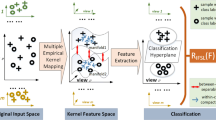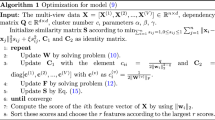Abstract
In this paper, we combined two steps in a new multi-view multi-manifold learning algorithm that are essential for recognition tasks in the absence of class label information; first, we emphasize the first step of graph-based multi-view multi-manifold learning methods, i.e., select class-consistent neighbors from all available views. In multi-manifold space, the ideal neighborhood set is unidentified, and selection of a proper neighborhood set is not an easy task, especially if manifolds have some intersections. We describe each class of objects with continuous varying of pose angle as a relatively independent object-manifold. To find the object-manifolds, we utilize the transitivity of the similarity in the objects and use the TV-regularization to describe each object in a weighted sum of its class-consistent neighbors under different views. The proposed method aims to make a distinction between some objects with the same class and some objects with different classes that have similar views. The proposed method can be efficiently solved by an ADMM method. Second, we propose a regularized approach for supervised dimension reduction via discovering the discriminating information hidden in the data structure. Neighborhood selection and recognition accuracy experiments on COIL-20, CAS-PEAL, FEI, and ORL multi-view datasets have shown the excellent performance of our novel approach.






Similar content being viewed by others
References
Suliman A, Omarov BS (2018) Applying Bayesian Regularization for Acceleration of Levenberg-Marquardt based Neural Network Training. International Journal of Interactive Multimedia and Artificial Intelligence 5(1):68–72
Magdin M, Prikler F (2018) Real-Time Facial Expression Recognition Using Webcam and SDK Affectiva. International Journal of Interactive Multimedia and Artificial Intelligence 5(1):7–15
Zhang Y, Ye D, Liu Y (2018) Robust locally linear embedding algorithm for machinery fault diagnosis. Neurocomputing 273(17):323–332
Ren S et al (2018) An iterative paradigm of joint feature extraction and labeling for semi-supervised discriminant analysis. Neurocomputing 273(17):466–480
Hu MW, Sun Z, Zhao S (2018) Kernel collaboration representation-based manifold regularized model for unconstrained face recognition. SIViP 12(5):925–932
Yang M et al (2017) Joint regularized nearest points for image set based face recognition. Image Vis Comput 58:47–60
Zhang Z, Mao J (2016) Jointly sparse neighborhood graph for multi-view manifold clustering. Neurocomputing 216(5):28–38
Lai Z, Wan M, Jin Z (2011) Locality preserving embedding for face and handwriting digital recognition. Neural Comput & Applic 20:565–573
Yan H et al (2014) Multi-feature multi-manifold learning for single-sample face recognition. Neurocomputing 143(2):134–143
Chen W-J et al (2014) Manifold proximal support vector machine for semi-supervised classification. Appl Intell 40(4):623–638
Belkin M, Niyogi P (2000) Laplacian eigenmaps for dimensional reduction and data representation. Neural Comput 15:1373–1396
Zhang Z, Zha H (2002) Principal Manifolds and Nonlinear Dimension Reduction via Local Tangent Space Alignment. SIAM Journal of Scientific Computing 26(1):313–338
Roweis ST, Saul LK (2000) Nonlinear dimensionality reduction by locally linear embedding. Science 290:2323–2326
Tenenbaum J, Silva V, Langford J (2000) A global geometric framework for nonlinear dimensionality reduction. Science 290(5500):2319–2323
Vlachos M, et al (2002) Non-linear dimensionality reduction techniques for classification and visualization. In: Proceedings of ACM Int. Conf. Knowl. Discovery Data Mining. ACM New York pp. 645–651
Belkin M, Niyogi P (2002) Laplacian eigenmaps and spectral techniques for embedding and clustering. In: Neural Information Processing Systems, pp. 585–591
Hettiarachchi R, Peters JF (2015) Multi-manifold LLE learning in pattern recognition. Pattern Recogn 48(9):2947–2960
Lee C-S, Elgammal A, Torki M (2016) Learning representations from multiple manifolds. Pattern Recogn 50:74–87
Fan M et al (2016) Efficient isometric multi-manifold learning based on the self-organizing method. Inf Sci 345:325–339
Yang B, Xiang M, Zhang Y (2016) Multi-manifold discriminant Isomap for visualization and classification. Pattern Recogn 55:215–230
Li B, Li J, Zhang X-P (2015) Nonparametric discriminant multi-manifold learning for dimensionality reduction. Neurocomputing 152(25):121–126
Li J et al (2016) Multi-manifold Sparse Graph Embedding for Multi-modal Image Classification. Neurocomputing 173(3):501–510
Sun S (2013) A survey of multi-view machine learning. Neural Comput & Applic 23:2031–2038
Li Y et al (2016) Manifold regularized multi-view feature selection for social image annotation. Neurocomputing 204(5):135–141
Nane SA, Nayar SK, Murase H (1996) Columbia object image library (COIL-20). Department of Computer Science: Columbia University
Gao W, Cao B, Shan S (2008) The CAS-PEAL Large-Scale Chinese Face Database and Baseline Evaluations. IEEE Transactions on Systems, Man, and Cybernetics—Part A: Systems and Humans 38(1)
Gao W et al (2008) The CAS-PEAL Large-Scale Chinese Face Database and Baseline Evaluations. IEEE Transactions on Systems, Man, and Cybernetics—Part A: Systems And Humans 38(1):149–161
Wang L, Zhang Y, Feng J (2005) On the Euclidean distance of images. IEEE Trans Pattern Anal Mach Intell 27(8):1334–1339
Geng X, Zhan DC, Zhou ZH (2005) Supervised Nonlinear Dimensionality Reduction for Visualization and Classification. IEEE Transactions On Systems, Man, And Cybernetics—Part B: Cybernetics 35(6):1098–1107
Raducanu B, Dornaika F (2012) A supervised non-linear dimensionality reduction approach for manifold learning. Pattern Recogn 45:2432–2444
Aeini F, Eftekhari Moghadam AM, Mahmoudi F (2014) Non linear dimensional reduction method based on supervised neighborhood graph. In: 7th International Symposium on Telecommunications (IST'2014). IEEE: Tehran. p. 35–40
Ridder DD, et al (2003) Supervised locally linear embedding. In: Artificial Neural Networks and Neural Information Processing-ICANN/ICONIP 2003. 2003, Springer. p. 333–341
Zhang Z, Chow TWS, Zhao M (2013) M-Isomap: Orthogonal Constrained Marginal Isomap for Nonlinear Dimensionality Reduction. IEEE Transactions on Cybernetics 43(1):180–191
Aeini F, Eftekhari Moghadam AM, Mahmoud F (2018) Supervised hierarchical neighborhood graph construction for manifold learning. SIViP 12(4):799–807
He X, Niyogi P (2004) Locality preserving projections. In: NIPS'03 Proceedings of the 16th International Conference on Neural Information Processing Systems. Whistler, British Columbia, Canada p. 153–160
Kokiopoulou E, Saad Y (2007) Orthogonal neighborhood preserving projections: A projection-based dimensionality reduction technique. IEEE Trans Pattern Anal Mach Intell 29(12):2143–2156
Cheng J et al (2005) Supervised kernel locality-preserving projections for face recognition. Neurocomputing 67:443–449
Fa X, et al (2011) Enhanced supervised locality preserving projections for face recognition, in International Conference on Machine Learning and Cybernetics
Fan M, et al (2012) Isometric multi-manifold learning for feature extraction. In: Proceedings of the Twelfth IEEE International Conference on Data Mining (ICDM). p. 241–250
Lu J, Tan Y-P, Wang G (2013) Discriminative Multimanifold Analysis for Face Recognition from a Single Training Sample per Person. IEEE Trans Pattern Anal Mach Intell 35(1):39–51
Liu J, Li B, Zhang W-S (2012) Feature extraction using maximum variance sparse mapping. Neural Comput & Applic 21:1827–1833
Feng P, Bresler Y (1996) Spectrum-blind minimum-rate sampling and reconstruction of multi-band signals. ICASSP3:1688–1691
Obozinski G, Taskar B, Jordan M (2010) Support union recovery in high-dimensional multi variate regression. Stat Comput 20(2):231–252
Fornasier M, Pitolli F (2008) Adaptive iterative thresholding algorithms for magnetoence phalography (MEG). Comput Appl Math 211:386–395
Nie F et al (2010) Efficient and robust feature selection via joint ℓ2,1-norms minimization. Adv Neural Inf Proces Syst 2:1813–1821
Maaten LJPVD, Postma EO, Herik HJVD (2009) Dimensionality Reduction: A Comparative Review. Mach Learn Res 10(1–41):66–71
Aeini F, Eftekhari Moghadam AM, Mahmoudi F (2018) A regularized approach for unsupervisedmulti-viewmulti-manifold learning. Signal, Image and Video Processing 1–9
Xu Y et al (2010) LPP solution schemes for use with face recognition. Pattern Recogn 43:4165–4176
Evgeniou T et al (2002) Regularization and statistical learning theory for data analysis. Computational Statistics & Data Analysis 38(4):421–432
Belkin M, Niyogi P, Sindhwani V (2006) Manifold Regularization: A Geometric Framework for Learning from Labeled and Unlabeled Examples. J Mach Learn Res 7:2399–2434
Schölkopf B, Herbrich R, Smola AJ (2001) A Generalized Representer Theorem. COLT 2001: Computational Learning Theory, p. 416–426
Thomaz CE, Giraldi GA (2010) A new ranking method for Principal Components Analysis and its application to face image analysis. Image Vis Comput 28(6):902–913
AT&T Laboratories Cambridge (2002) The ORL database of faces. "http://www.cl.cam.ac.uk/research/dtg/attarchive/facedatabase.html. (Online;accessed 23.12.2014). Cambridge University Computer Laboratory
Tran L et al (2015) Adaptive graph construction for Isomap manifold learning. Article (PDF Available). Proceedings of SPIE - The International Society for Optical Engineering 1:1–7
Örnek C, Vural E (2019) Nonlinear supervised dimensionality reduction via smooth regular embeddings. Pattern Recogn 87:55–66
Yan Y et al (2018) Face recognition algorithm using extended vector quantization histogram features. PLoS One 13(1)
Zhang Z, Song G, Wu J (2014) A Novel Two-Stage Illumination Estimation Framework for Expression Recognition. Sci World J 2014:1–12
Tsai Y-H et al (2018) Robust in-plane and out-of-plane face detection algorithm using frontal face detector and symmetry extension. Image Vis Comput 78:26–41
Abhishree TM et al (2015) Face Recognition Using Gabor Filter Based Feature Extraction with Anisotropic Diffusion as a Pre-processing Technique. Procedia Computer Science 45:312–321
Raducanu B, Dornaika F (2014) Embedding new observations via sparse-coding for non-linear manifold learning. Pattern Recogn 47(1)
Samaria F, Harter A (1994) Parameterisation of a Stochastic Model for Human Face Identification, in Proceedings of 2nd IEEE Workshop on Applications of Computer Vision, Sarasota FL. IEEE: Sarasota
Wasserman PD (1993) Advanced methods in nerual computing. Van Nostrand reinhold, New York
Nane, S.A., S.K. Nayar, and H. Murase (1996) Columbia object image library (coil-20). Technical Report CUCS-005-96
Author information
Authors and Affiliations
Corresponding author
Additional information
Publisher’s note
Springer Nature remains neutral with regard to jurisdictional claims in published maps and institutional affiliations.
Rights and permissions
About this article
Cite this article
Aeini, F., Eftekhari Moghadam, A.M. & Mahmoudi, F. A regularized approach for supervised multi-view multi-manifold learning from unlabeled data. Appl Intell 49, 3173–3187 (2019). https://doi.org/10.1007/s10489-019-01411-w
Published:
Issue Date:
DOI: https://doi.org/10.1007/s10489-019-01411-w




